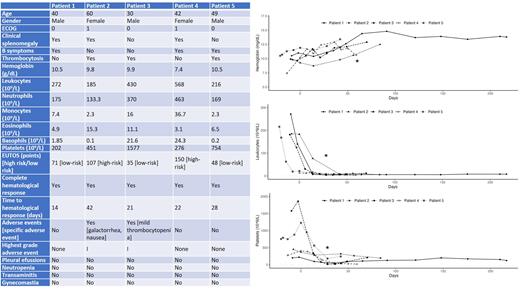Introduction The standard treatment for newly diagnosed (ND)-CML is tyrosine kinase inhibitors (TKIs) such as dasatinib. However, the cost of treatment with these drugs can be prohibitively high. The CYP inhibition strategy involves intentionally inhibiting a specific enzyme, in this case CYP3A4, to increase plasma concentration of dasatinib and reduce the required dose from 100mg to 25mg daily.
Patients and methods Five consecutive patients older than 18 years, with ND-CML in chronic phase and Eastern Cooperative Oncology Group (ECOG) of 0-2.The diagnosis and classification of CML followed the ESMO guidelines.
After diagnostic confirmation, patients continuously received half pill of dasatinib (25mg orally daily) and a strong CYP3A4 inhibitor (ketoconazole, 200mg orally twice daily). Patients were monitored weekly during the first month and then monthly after that. The response to treatment was established according to the ESMO guidelines.
Statistical analysis We examined the distribution of variables using the Shapiro-Wilk test, and descriptive analyses were conducted for demographic and clinical characteristics. The proportion of hematological and non-hematological side effects and the proportion of hematological response were obtained. To demonstrate the effect of dasatinib on hematological cells, we constructed a line plot showing the values of hemoglobin, leukocytes, and platelets in each visit. We compared basal hemoglobin, leukocytes, and platelets vs. follow-up counts at each visit with the Kruskal-Wallis test
Results The median age of the patients was 42 years. All patients had a median ECOG score of 0. Three patients (60%) presented with thrombocytosis, three (60%) with splenomegaly, and two patients (40%) had B symptoms. Basal median (range) hemoglobin, leukocytes, and platelets counts were 9.9 g/dL , 272×10 9/L and 451×10 9/L, respectively. Three patients (60%) had low-risk CML, and two patients (40%) had high-risk disease, with a median EUTOS score of 71 points. Dasatinib treatment was initiated within a median of 9 days from diagnosis.
In the first 28 days of treatment, median leukocytes and platelets were significantly reduced compared to baseline, with a reduction in leukocytes of 93.7% (125×10 9/L vs. 7.9×10 9/L, p=0.005) and in platelets of 64.6% (407×10 9/L, vs. 144×10 9/L, p=0.027). Hemoglobin levels significantly increased by the second month of treatment, with an increase of 26.4% from baseline (10.2 g/dL vs. 12.9 g/dL, p=0.023).
All patients (100%) achieved major hematological response within a median of 22 days. Patient number 1 achieved the 3-month and 6-month treatment goals with 6.4% and <1% reduction in BCR-ABL transcript levels, respectively. After 3 months of treatment, 60% of patients achieved the BCR/ABL1 transcript level on the IS <10%, which is the optimal response according to guidelines, in the rest of the patients the time of evaluation has not been reached.
Mild and self-limited adverse events were reported in 40% of patients at some point in their treatment. Non-hematological toxicity occurred in one patient (20%) with nausea and galactorrhea due to ketoconazole. Hematological toxicity occurred in (20%) of patients; the platelet count returned to normal after suspending ketoconazole for one week. No serious adverse events were reported.
Conclusion Apart from this preliminary study, there is currently no evidence supporting the intentional use of CYP inhibition to reduce the dosage and cost of dasatinib for patients with ND-CML. Dasatinib is primarily metabolized using the CYP3A4 isoenzyme, and studies have shown that ketoconazole, an accessible antifungal, can strongly inhibit CYP3A4, increase dasatinib's plasma concentration and AUC by 5-fold and 385%, respectively, and allow for a reduction in dosage while maintaining therapeutic efficacy.
The CYP inhibition strategy can decrease the cost of dasatinib to a point where it is cheaper than full-dose imatinib -the cheapest TKI- and represent a treatment option for patients who cannot afford full-dose dasatinib in low income countries.
The CYP inhibition strategy can be of added value to the lower effective dose concept and give rise to ultra-low-dose schemes. This strategy could significantly increase dasatinib accessibility in many countries by reducing costs from $1,343.7 to $40.3-$100.8 monthly
OffLabel Disclosure:
Gomez-Almaguer:AMGEN: Consultancy, Honoraria; Janssen: Consultancy, Honoraria; Novartis: Honoraria; AbbVie: Consultancy, Honoraria.
Patients continuously received dasatinib (25mg orally daily) and a strong CYP3A4 inhibitor (ketoconazole, 200mg orally twice daily).


This feature is available to Subscribers Only
Sign In or Create an Account Close Modal